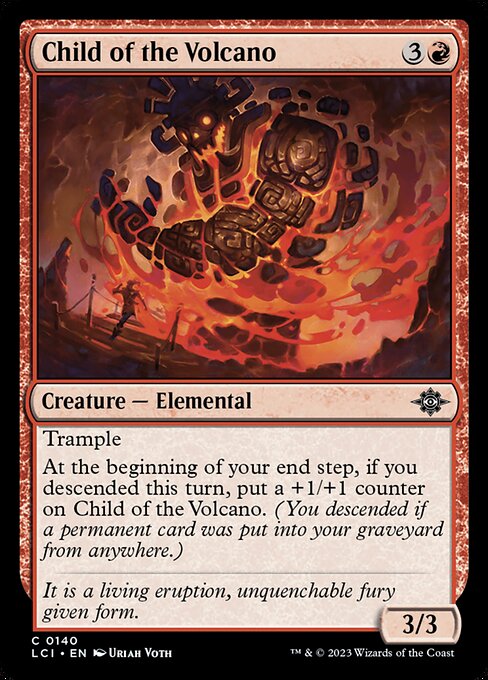
Image courtesy of Scryfall.com
Reprints and the Price Pulse: Reading Child of the Volcano Through Market Waves
In the grand theater of MTG economics, reprints are the plot twists you didn’t know you needed—sometimes they flood the market, sometimes they spark renewed interest in a mechanic or faction. Child of the Volcano, a red creature with trample and a clever “descend” twist, sits at the crossroads where design ambition meets market dynamics. The card costs {3}{R} and sits as a 3/3 on the battlefield, a sturdy body for a red deck that wants momentum and menace. But what happens to its price when Wizards of the Coast revisits the Ixalan mythos or repeatedly prints descend-friendly cards? The short answer: supply shifts matter, but so do deck-building trends and the broader health of red aggro in the format you care about. 🧙♂️🔥
Let’s anchor this with the card’s current context. The Lost Caverns of Ixalan print, identified by its set tag lci, presents Common level scarcity for a 4-mana threat that brings trample and a persistent growth mechanic tied to the graveyard. Its oracle text—“Trample. At the beginning of your end step, if you descended this turn, put a +1/+1 counter on this creature. (You descended if a permanent card was put into your graveyard from anywhere.)” —is a mouthful of flavor that translates to a surprisingly practical top-end threat in decks that want to push damage across the board as the game swings into the late turns. As of the latest data, the card sits around a few nickels on the open market, with foil still under a dollar. That baseline makes it a natural target for reprint talk: if a commons slot in a bigger set reappears, will its price slip further or will a broader red-aggro strategy keep it relevant? 🧨💎
What drives price movement for a card like this?
There are three levers that typically move the needle: supply, demand in commander and modern formats, and the card’s role in synergy-driven archetypes. For Child of the Volcano, the descending mechanic creates a tactical hook: it rewards players who stack graveyard interactions and can set up end steps where a dented board gets a surprise +1/+1 boost. When reprints reintroduce descend-focused cards or flood the market with more red creatures, the supply side grows substantially. If the card becomes a generic staple in red-based aggro, however, there’s a counter-pressure: the market may tolerate a lower price longer because there are more copies circulating, and new players can snag a deck-ready version without breaking the bank. The current price tag—mere cents for nonfoil, a touch more for foil—means that any reprint shock is likely to be a gentle one in the near term, with longer-term effects highly dependent on print cadence and the card’s continued relevance in formats like Pioneer, Modern, or even casual kitchen-table play. 🧲🎲
Meanwhile, the foil market often behaves differently from nonfoil. For a common with a low price floor, foil premiums tend to be modest, but foil copies can hold value as collectors chase condition and aesthetics. That dynamic matters when a reprint lands; the foil pool can dry up in some printings, buoying prices temporarily even as nonfoil copies flood the market. In the end, reprints tend to compress the range, but strong demand in specific formats can carve out price floors that surprise newcomers who expect a flat drop across the board. ⚔️🧪
Strategies for players and collectors when reprints loom
- Players: If you’re eyeing a red creature tempo plan, weigh the immediacy of structural fit against the risk of a near-future reprint. Price dips can be a signal to pick up a copy for your casual or Commander deck, but avoid overpaying for a card that could see a broader supply spike. Track trend lines across major marketplaces; small dips can be temporary blips on a longer downward slope, or they can presage a reprint wave. 🧙♂️
- Collectors: Foils matter here—if you’re chasing look and rarity, foil copies offer a different value trajectory than nonfoil. Consider keeping a small reserve of intact foils as a hedge against sudden price volatility, especially if the set’s print run seems limited or if descend-themed cards become a focal point in a newer Commander precon. 💎
- Deck builders: The descend trigger rewards graveyard-centric plays. If a reprint hits and other descend-enabled cards follow, iterative builds might emerge that turn a humble 3/3 into a late-game menace. Watching for synergy shifts can help you pivot mid-season to a more impactful strategy. 🔥
- Places to monitor: Use price trackers and set announcements to gauge when a reprint becomes likely. In the meantime, you can enjoy crafting flexible red shell lists that benefit from trample and incremental growth. 🎨
Cross-promotional moment: a tiny BLIP in the hobby economy
While we nerd out over mana curves and graveyard math, there’s a real-world tie-in: the MTG community thrives on cross-pollination with pop culture and practical goods. If you’re stocking your desk or your play area with gadgets, a small, vibrant product like a Phone Grip Click-On Reusable Adhesive Holder Kickstand can be a playful nod to the tactile joy of gaming. The link below leads to a modern accessory that fits the spirit of the hobby—tiny conveniences that make long sessions a little smoother. 🎨
Phone Grip Click-On Reusable Adhesive Holder Kickstand
More from our network
- https://crypto-acolytes.xyz/blog/post/unraveling-team-flares-plans-in-pokemon-x-and-y/
- https://blog.digital-vault.xyz/blog/post/post-launch-scaling-how-to-handle-surges-and-stabilize-performance/
- https://blog.digital-vault.xyz/blog/post/fomantis-competitive-tier-placement-where-it-belongs/
- https://crypto-acolytes.xyz/blog/post/global-crypto-regulation-what-comes-next/
- https://blog.digital-vault.xyz/blog/post/bloodthirster-unhinged-parody-and-humor-in-mtg-cards/